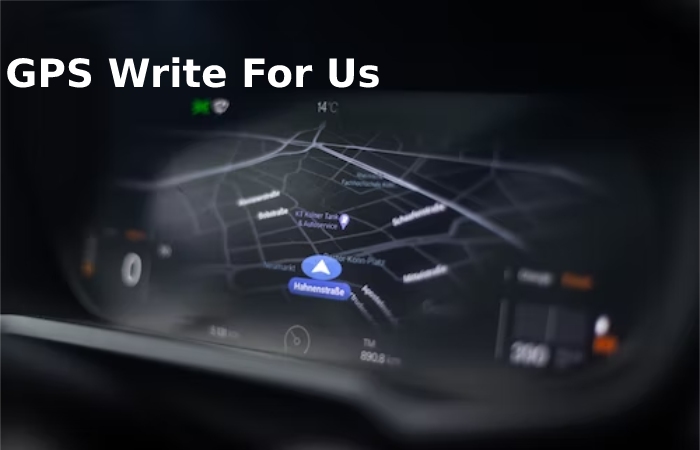GPS Write For Us – GPS, or global positioning system, is a global navigation satellite system that provides information regarding location, speed, and time harmonization.GPS is everywhere. You can find GPS systems in your car, your smartphone and your watch. GPS helps you get to your destination, from point A to point B. What is ? Read this article to find out how it works, its history and future developments.
What does GPS mean and how does it work?
Global Positioning System is a steering system that uses satellites, a receiver, and algorithms to synchronize location, speed, and time data for air, sea, and land travel.The satellite system is made up of a constellation of 24 satellites in six Earth-centered orbital planes, each with four satellites, orbiting 13,000 km above the Earth at a speed of 14,000 km/h .is made up of three different mechanisms, called sections, that work together to provide location information.
The three GPS segments are:
- Space (satellites): the satellites that revolve around the Earth, transmitting to the users signals about the geographical position and the time of day.
- Ground control: the control segment is integrated by ground monitoring stations, main control stations and ground antenna. Control activities include the tracking and operation of satellites in space and the monitoring of transmissions. There are monitoring stations present on almost every continent in the world, including Asia, Africa, North and South America, Europe, and Australia.
- User Equipment: GPS transmitters and receivers, including items such as watches, smartphones, and telematics devices.
How does GPS technology work?
GPS works through a technique called trilateration. Used to calculate location, speed, and elevation, trilateration collects signals from satellites to send location information. It is often confused with triangulation, which is used to measure angles, not distances.Cables orbiting the Earth send signals to be read and interpreted by a device located on or near the Earth’s surface. To calculate the location, a GPS device must be able to read the signal from at least four satellites.
What are the uses of GPS?
GPS is a powerful and reliable tool for businesses and businesses in many different industries. Surveyors, scientists, pilots, skippers, emergency personnel, and mining and agricultural workers are some of the people who use GPS on a daily basis in their work. They use the information to prepare accurate maps and plans, take accurate time measurements, track position or location, and for navigation. GPS works 24/7 and in almost all weather conditions.
There are five main uses of GPS:
- Location: determination of a position.
- Navigation: Moving from one location to another.
- Tracking: monitoring the movement of objects or people.
- Cartography: creating maps of the world.
How accurate is the GPS?
The accuracy of a GPS device depends on many variables, including but not limited to the number of available satellites, the ionosphere, and the urban environment.
Some of the factors that can affect accuracy are:
- Physical Obstructions: Time-of-arrival measurements can be disturbed by bulky masses such as mountains, buildings, trees, and other structures.
- Atmospheric Effects: Ionospheric delays, severe storms, and solar storms can affect GPS devices.
- Ephemeris: The internal orbital model of a satellite could be incorrect or out of date, although this is increasingly rare.
- Erroneous numerical calculations: This aspect can influence when the hardware of the device has not been designed according to the specifications.
Brief history of GPS
Humanity has spent thousands of years perfecting navigation, first orienting itself by the sun, the moon and the stars, and later, through the use of the sextant. GPS was a 20th century advance made possible by space age technology.
GPS technology has been used globally throughout recent history. The launch of the Russian Sputnik I satellite in 1957 opened the door to the possibility of geolocation capabilities, and shortly thereafter the US Department of Defense began using it for underwater navigation.
In 1983, the United States government made available to the public, but continued to maintain control of the data available. It wasn’t until 2000 that businesses and the general public gained full access to the use of GPS, paving the way for further advancement of GPS.
Global steering cable systems (GNSS)
A GPS is careful to be a Global Steering Satellite System (GNSS), which means that it is a satellite navigation system with worldwide coverage. As of 2020, there are two completely operational global navigation satellite systems: the US GPS Navigation Signal Ranging and Synchronization (NAVSTAR) and the Russian Global Navigation Satellite System (GLONASS). NAVSTAR GPS consists of 32 US-owned satellites and is the most well-known and widely used satellite system. The Russian GLONASS consists of 24 operational satellites and three spare or testing ones.
GPS satellite system
The 24 satellites that make up the GPS space segment orbit the earth some 12,000 kilometers above us. They are constantly moving, making two complete orbits in less than 24 hours. These satellites are traveling at speeds of approximately 7,000 miles per hour.
GPS satellites are powered by solar energy. They have backup batteries on board to keep them running in the event of a solar eclipse, when there is no solar power. The little rocket boosters on each satellite keep them flying on the right track.
gps signal
GPS satellites transmit two low-power radio signals, called L1 and L2. Civilian GPS uses the L1 frequency of 1575.42 MHz in the UHF band. The signals travel by line of sight, which means they will pass through clouds, glass, and plastic, but will not pass through most solid objects like buildings and mountains.
A GPS signal contains three different bits of information: a pseudorandom code, ephemeris data, and almanac data. The pseudorandom code is simply an identification code that identifies which satellite is transmitting information. You can see this number on the satellite page of your Garmin GPS unit, as it identifies which satellites you are receiving.

Likewise, You can submit your articles at contact@minisecond.com
How to Submit Your GPS Articles GPS Write For Us?
That is to say, To submit your article at www.minisecond.com, mail us at contact@minisecond.com
Why Write for Mini Second – GPSWrite For Us
GPS Write For Us
That is to say, here at Mini Second, we publish well-researched, informative, and unique articles. In addition, we also cover reports related to:
Satellite navigation device
GPS (disambiguation).
satellite-based radionavigation
United States government
United States Space Force
global navigation
satellite systems
geolocation
time information
GPS receiver
Galileo
GLONASS,
global navigation
satellite systems


